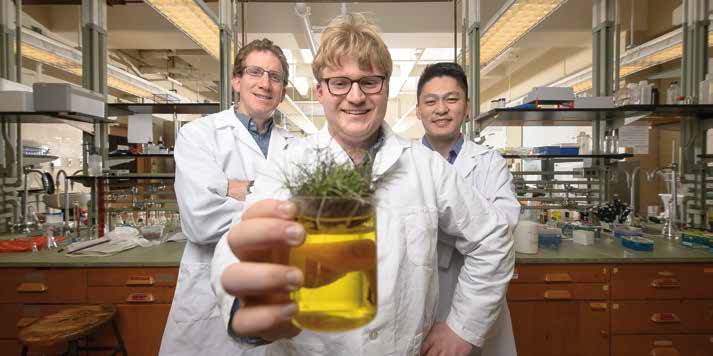Flush in Nutrients: Student Project Transforms Urine into Fertilizer
Processing human waste is a circular affair. We fill toilets with potable water, only to contaminate it with nutrient-rich urine. We flush the fouled water to treatment plants, where it’s stripped of nutrients, cleaned — and pumped back into toilets.
“When you think about it, it makes no sense,” says Professor Ernest “Chip” Blatchley, who holds appointments in civil engineering and environmental and ecological engineering. “Urine is loaded with nitrogen, phosphorus and potassium,” Blatchley says. “It’s a remarkably valuable commodity.”
Pondering this during a 2014 “Maymester” class, Blatchley asked students: What would be the implications if 50 percent of the urine from the Purdue campus were diverted from the City of West Lafayette water treatment plant?
When he worked up the key, Blatchley was startled by the potential quantity of recoverable nutrients that could be reclaimed as fertilizer. Students, too, were amazed. Several were so intrigued that they petitioned Blatchley to let them build a urine recovery reactor in the civil engineering building. “How could I say no?” he smiles.
Today, top-notch engineering students tinker with test reactors in the Delon and Elizabeth Hampton Hall of Civil Engineering. Students hope to demonstrate the feasibility of a waste management system that could both lighten the load on the local water treatment plant and provide the university an income source: fertilizer. Also contributing to the project is Zhi "George" Zhou, assistant professor of civil engineering and environmental and ecological engineering.
The nutrient recovery experiments are based on work done by others, including the Swiss Federal Institute of Aquatic Science and Technology (EAWAG), which has already demonstrated the feasibility of reclaiming urine as fertilizer — in one of its buildings, which is roughly the size of Hampton Hall.
Nathaniel Kallmyer, a senior double-majoring in chemistry and chemical engineering, became involved with the project via the Summer Undergraduate Research Fellowship, or SURF, Program. He’s interested in renewables and reaction engineering, and the biochemistry of the Hampton Hall reactor appealed to him. It employs bacteria used by water treatment plants to convert ammonia in urine to nitrate, a form of nitrogen that plants can use.
"The major issue now is that ammonia in urine is 50 to 100 times more concentrated than the wastewater these bacteria are used to," Kallmyer says. "To adapt this population to higher concentrations of ammonia, we’re gradually increasing the concentration we feed the bacteria."
Blatchley is optimistic that, using Hampton Hall as a living lab, students will develop a workable reactor process that could be implemented in other buildings on campus. “It’s a learning opportunity,” he says. “And a business opportunity.”

Presenting a simulation of his project's goal, SURF student Nathaniel Kallmyer (center) stands with his faculty mentors, Professor Ernest "Chip" Blatchley (left), and Professor Zhi "George" Zhou. (Photo: Charles Jischke)
